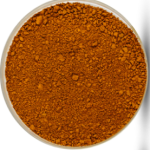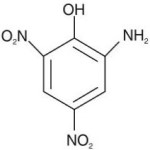Picramic Acid SDS of Suppliers Exporters, Manufacturers
Picramic Acid
CAS Number: 96-91-3 2-Amino-4,6-dinitrophenol Suppliers Exporters, Manufacturers

Please visit Main Page of Picramic Acid or 2-Amino-4,6-dinitrophenol Manufacturers.
Picramic Acid or 2-Amino-4,6-dinitrophenol SDS, Safety Data Sheet
MSDS Sheet, Material Safety Data Sheet 15-Nov-20
1. Product Identification
Product Name & Other Names: Picramic Acid or 2-Amino-4,6-dinitrophenol.
CAS Number: 96-91-3.
EINECS EC Number: 202-544-6
Molecular Formula: C6H5N3O5
Molecular Weight: 199.12
Relevant uses and uses advised against (if any): Laboratory and Industrial Use.
Supplier: As per letterhead.
2. Hazards Identification
GHS, Globally Harmonized System Classification in accordance with 29 CFR 1910
Classification according to Regulation (EC) No 1272/2008
Flammable liquids Category 2 - H225
Acute toxicity, oral Category 4 - H302
Acute toxicity, dermal Category 4 - H312
Skin irritation Category 2 - H315
Acute toxicity, inhalation Category 4 - H332
Serious eye damage/eye irritation Category 2A - H319
Labeling according GHS USA & Regulation (EC) No 1272/2008
GHS Label Elements  Flammable |
GHS Label Elements |
Signal Words: Danger
Hazard Statements:
H225: Highly flammable liquid and vapor.
H302+H312+H332: Harmful if swallowed, in contact with skin or if inhaled.
H315: Causes skin irritation.
H319: Causes serious eye irritation.
Precautionary Statements:
P210: Keep away from heat/sparks/open flames/hot surfaces – No smoking.
P240: Ground/bond container and receiving equipment.
P241: Use explosion-proof electrical/ventilating/light/…/equipment.
P242: Use only non-sparking tools.
P243: Take precautionary measures against static discharge.
P260: Do not breathe dust/fume/gas/mist/vapors/spray.
P264: Wash contaminated parts thoroughly after handling.
P270: Do not eat, drink or smoke when using this product.
P280: Wear protective gloves/protective clothing/eye protection/face protection.
P312: Call a POISON CENTER or doctor/physician if you feel unwell.
P301+P310: IF SWALLOWED: Immediately call a POSION CENTER or doctor/physician.
P303+361+353: IF ON SKIN (or hair): Remove/Take off immediately all contaminated clothing. Rinse skin with water/shower.
P333+313: If skin irritation or a rash occurs: Get medical advice/attention.
P370+378: In case of fire: Use Dry powder. Dry sand. Water fog. Alcohol foam. Dry chemical. Polymer foam. Carbon dioxide (CO2). Do not use a solid water stream as it may scatter and spread fire.
P403+233+235: Store in a well-ventilated place. Keep container tightly closed. Keep cool.
P362: Take off contaminated clothing and wash before reuse.
P501: Dispose of contents/container in accordance with local/national regulation.
Classification according to EU Directives 67/548/EEC or 1999/45/EC:
Hazard Symbols:
F Flammable
Xn Harmful
Xi Irritant
Risk Phrases:
R11 Highly flammable.
R20/21/22 Harmful by inhalation, in contact with skin and if swallowed.
R36/37 Irritating to eyes and in contact with skin.
3. Composition/Information on Ingredients
Product Name & Other Names: Picramic Acid or 2-Amino-4,6-dinitrophenol.
CAS Number: 96-91-3.
EINECS EC Number: 202-544-6
4. First Aid Measures
Always seek medical attention after first aid measures are provided.
Inhalation: Remove to fresh air. If not breathing, give artificial respiration. If breathing is difficult, give oxygen. Do not use mouth-to-mouth method if victim inhaled the substance. Induce artificial respiration with the aid of a pocket mask equipped with a one-way valve or other proper respiratory medical device. Get medical attention.
Ingestion: Rinse mouth. Do not induce vomiting without medical advice. If vomiting occurs naturally, have victim lean forward to reduce risk of aspiration. Never give anything by mouth to a victim who is unconscious or is having convulsions. Get medical attention.
Skin Contact: Wipe off excess material from skin then immediately flush skin with plenty of water for at least 15 minutes. Use a mild soap if available. Remove contaminated clothing and shoes. Get medical attention. Wash clothing before reuse. Thoroughly clean shoes before reuse. For minor skin contact, avoid spreading material on unaffected skin.
Eye Contact: Immediately flush eyes with plenty of water for at least 15 minutes, lifting lower and upper eyelids occasionally. Get medical attention immediately.
5. Fire Fighting Measures
Flammability of the Product: Flammable. Containers may explode when heated.
Products of Combustion: Carbon oxides, nitrogen oxides and toxic and fumes.
Fire Extinguishing Media: Dry powder and Dry sand is preferred. Water fog, Alcohol foam, Dry chemical, Polymer foam, Carbon dioxide (CO2) may also be used. Do not use a solid water stream as it may scatter and spread fire. Fire residues and contaminated fire extinguishing water must be disposed of in accordance with local regulations. In the event of fire and/or explosion do not breathe fumes.
Extinguishing Media Not recommended: Avoid using solid water jet as it may scatter the fire.
Special Information: In the event of a fire, wear full protective clothing and NIOSH-approved self-contained breathing apparatus with full face piece operated in the pressure demand or other positive pressure mode. At high temperatures under fire conditions, it may produce toxic or irritating fumes. Fire-extinguishing work is done from the windward and the suitable fire-extinguishing method according to the surrounding situation is used. Uninvolved persons should evacuate to a safe place.
6. Accidental Release Measures
Personal precautions, protective equipment, and emergency procedures: Avoid breathing dust/fumes/gas/mist/vapors/spray. Use individual protective equipment (waterproof boots, suitable protective clothing, safety glasses, etc). Restrict unprotected personnel from the area. Prevent any contact with hot surfaces. Do not approach facing the wind. Do not touch the spilled material.
Environmental precautions: Do not let the product enter drains, soil, or water sources.
Methods and materials used for containment Cleanup procedures and Storage: Contain spilled material. Cover with an inert, non-combustible absorbent material, (e.g. sand, earth, diatomaceous earth, vermiculite). Vacuum or sweep up and remove to an approved disposal container. Eliminate all ignition sources (no smoking, flares, sparks, or flames in immediate area). Stop leak if you can do so without risk. Move containers to a safe and open area if the leak is irreparable. Dike the spilled material, where this is possible.
7. Handling and Storage
Provide sufficient air exchange and/or exhaust in work rooms. Remove all sources of ignition. To avoid ignition of vapors by static electricity discharge, all metal parts of the equipment must be grounded. Keep away from incompatible materials.
Precautions for safe handling: Do not handle or store near an open flame, heat, or other sources of ignition. All equipment used when handling the product must be grounded. Apply according to good manufacturing and industrial hygiene practices. Ensure proper ventilation. Wash thoroughly after handling. Avoid prolonged exposure. Do not drink, eat, or smoke while handling. Avoid contact with skin, eyes, and clothing. Minimize dust generation. Avoid breathing dust/fumes/gas/mist/vapors/spray. Avoid contact with eyes, skin, and clothing. Keep container tightly closed. Use individual protective equipment (waterproof boots, suitable protective clothing, safety glasses, etc). Prevent any contact with hot surfaces.
Conditions for safe storage, including any incompatibilities: Store in cool, dry, and ventilated area away from heat sources and protected from heat, sources of ignition (spark or flame) and sunlight in tightly closed original container. Keep air contact to a minimum. Do not leave the material container open. Store protected from heat, sparks and ignition sources and incompatible materials. Avoid contact with skin and eyes. Avoid inhalation of dust/mist/vapor. Do not store with incompatible materials like Strong oxidizing agents.
8. Exposure Controls/Personal Protection
Airborne Exposure Limits:
USA ACGIH TWA= 1 ppm TWA.
OSHA PEL (TWA) (ppm)= 5 ppm TWA
Ventilation System: A system of local and/or general exhaust is recommended to keep employee exposures as low as possible. Local exhaust ventilation is generally preferred because it can control the emissions of the contaminant at its source, preventing dispersion of it into the general work area.
Personal Respirators (NIOSH Approved): For conditions of use where exposure to dust or mist is apparent and engineering controls are not feasible, a particulate respirator may be worn. For emergencies or instances where the exposure levels are not known, use a full-face positive-pressure, air-supplied respirator.
Skin Protection: Wear protective gloves and clean body-covering clothing.
Eye Protection: Use chemical safety goggles and/or full face shield where dusting or splashing of solutions is possible. Maintain eye wash fountain and quick-drench facilities in work area.
Other Control Measures: Maintain good housekeeping in work area. Handle in accordance with good industrial hygiene and safety practice. Wash hands after handling.
9. Physical and Chemical Properties
Appearance: Light yellow to Brown powder to crystal..
Odor: No data found.
Odor threshold: No data found.
pH: No data found.
Relative density: No data found.
Flash Point: 210C.
Boiling point: 386C.
Melting point/Freezing point: 168 to 173C literature..
Auto-ignition temperature: No data found.
Decomposition temperature: Not available.
Upper/lower flammability or explosive limits: Not available.
Vapor pressure: Not available.
Vapor density: Not available.
Evaporation rate: No data found.
Flammability (solid, gas): No data found.
Partition coefficient: n-octanol/water: No data found.
Solubility(ies): Insoluble in water. Soluble in Benzene, Alcohol and Aniline.
Viscosity: No data found.
Molecular Formula: C6H5N3O5
Molecular Weight: 199.12
10. Stability and Reactivity
Stability: It is stable under ordinary conditions of use and storage.
Hazardous Decomposition Products: It emits carbon oxides, nitrogen oxides and toxic fumes when heated to decomposition.
Hazardous Polymerization: Will not occur.
Incompatibilities: Strong oxidizing agents.
Conditions to Avoid: Avoid heat, sparks, open flames, and other ignition sources. Avoid temperatures exceeding the flash point. Contact with incompatible materials.
11. Toxicological Information
Toxicity data:
LC50 Inhalation - Rat: Not available.
Carcinogenicity: Not reported as carcinogen.
Mutagenic Effects: Not available.
Developmental Toxicity: Not available.
Reproductive Effects: No information available.
12. Ecological Information
Toxicity to fish: Not available.
Persistence and Degradability: Not available.
Mobility: Not available.
Bioaccumulation/ Accumulation: No information available.
Results of PBT and vPvB assessment: Not available.
13. Disposal Considerations
Whatever cannot be saved for recovery or recycling should be managed in an appropriate and approved waste disposal facility. Processing use or contamination of this product may change the waste management options. State and local disposal regulations may differ from federal disposal regulations. Dispose of container and unused contents in accordance with federal, state, and local requirements.
14. Transport Information
DOT USA, TDG Canada & ADR/RID Europe:
Proper shipping name: 2-Amino-4,6-dinitrophenol, wetted.
Class: 4.1 Flammable; Packing group: I.
UN number: 3317
Air transport IATA & Sea Transport IMDG/IMDG:
Proper shipping name: 2-Amino-4,6-dinitrophenol, wetted.
Class: 4.1 Flammable; Packing group: I.
UN number: 3317
15. Regulatory Information
USA:
SARA 311/312 Hazards: Fire Hazard, Acute Health Hazard. See section 2.
California Prop. 65 Components: This product does not contain any chemicals known to State of California to cause cancer, birth defects, or any other reproductive harm.
Section 16 - Additional Information
European Labeling in Accordance with EC Directives:
H225: Highly flammable liquid and vapor.
H302+H312+H332: Harmful if swallowed, in contact with skin or if inhaled.
H315: Causes skin irritation.
H319: Causes serious eye irritation.
Classification according to EU Directives 67/548/EEC or 1999/45/EC:
Hazard Symbols:
F Flammable
Xn Harmful
Xi Irritant
Risk Phrases:
R11 Highly flammable.
R20/21/22 Harmful by inhalation, in contact with skin and if swallowed.
R36/37 Irritating to eyes and in contact with skin.
Disclaimer:
****************************
The information and recommendations set forth herein are presented in good faith and believed correct as of the date the SDS was created. It is compiled from various sources and it is not necessarily all inclusive nor fully adequate in every circumstance. In addition, these suggestions should not be confused with nor followed in violation of applicable laws, regulations, rules, or insurance requirements applicable. This SDS is intended only as a guide to the appropriate precautionary handling of the material by a professionally trained person using this product. Individuals receiving the information must exercise their independent judgment in determining its appropriateness for a particular purpose. This shall not constitute a guarantee for any specific product features and shall not establish a legally valid contractual relationship.
****************************

Please visit Technical Data Sheet of Picramic Acid or 2-Amino-4,6-dinitrophenol Suppliers.
Picric Acid CAS Number 88-89-1, Picramic acid CAS Number 96-91-3 & Sodium Picramate CAS Number 831-52-7 Supplier Exporter, Manufacturer:
Annie Chemie P Ltd
Mumbai 4000010, INDIA
With Agents and offices in UAE, USA, Europe.
e-mail: info@anniechemie.com
Copyright and Usual Disclaimer is Applicable.
June 1, 2025
Exporters to USA, Canada, UK, Europe, UAE, Nigeria, Algeria, Turkey, Mexico, Brazil, Chile, Argentina, Australia, Dubai etc.
Perfection is made up of small things and that is a big thing.

